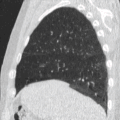4DCT
4DCT[edit]
-
Spiral 4DCT Lung (Post)
-
Spiral 4DCT Lung (Lateral)
4DCT[edit]
4DCT, or four-dimensional computed tomography, is an advanced imaging technique used primarily in the field of radiation therapy and diagnostic radiology. It extends the capabilities of traditional CT scanning by incorporating the dimension of time, allowing for the visualization of dynamic processes within the body, such as respiration or cardiac motion.
Principles of 4DCT[edit]
The fundamental principle of 4DCT is to acquire multiple CT images over a period of time, capturing the motion of anatomical structures. This is particularly useful in areas where movement can affect the accuracy of imaging, such as the thorax and abdomen. By synchronizing image acquisition with the patient's respiratory cycle, 4DCT can provide a series of images that represent different phases of motion.
Image Acquisition[edit]
In 4DCT, images are typically acquired using a multislice CT scanner equipped with software capable of sorting images based on the phase of the motion cycle. The patient may be asked to breathe in a controlled manner, often with the aid of a respiratory gating device, to ensure consistent and repeatable motion patterns.
Data Processing[edit]
Once the images are acquired, they are processed to create a time-resolved series of images. This involves sorting the images into bins corresponding to different phases of the motion cycle. The result is a set of volumetric images that can be viewed sequentially to assess motion.
Applications of 4DCT[edit]
4DCT is primarily used in the planning and delivery of radiation therapy for cancer treatment. It allows for more precise targeting of tumors by accounting for their movement during the respiratory cycle. This is particularly important in lung cancer and liver cancer treatments, where tumor motion can significantly impact the accuracy of radiation delivery.
Radiation Therapy Planning[edit]
In radiation therapy, 4DCT helps in creating a more accurate treatment plan by providing detailed information about tumor motion. This enables the use of techniques such as intensity-modulated radiation therapy (IMRT) and stereotactic body radiation therapy (SBRT), which require precise targeting to minimize damage to surrounding healthy tissue.
Diagnostic Imaging[edit]
Beyond radiation therapy, 4DCT is also used in diagnostic imaging to assess the function of moving organs. For example, it can be used to evaluate diaphragmatic motion or to study the dynamics of heart valves.
Advantages and Limitations[edit]
Advantages[edit]
The primary advantage of 4DCT is its ability to provide detailed information about the motion of anatomical structures, leading to improved accuracy in both diagnosis and treatment. It enhances the ability to visualize and quantify motion, which is critical in many clinical scenarios.
Limitations[edit]
Despite its advantages, 4DCT has limitations, including increased radiation dose due to the need for multiple image acquisitions. Additionally, the complexity of data processing and the need for specialized equipment can limit its availability and use in some clinical settings.
Related pages[edit]
| Medical imaging | ||||||||||
|---|---|---|---|---|---|---|---|---|---|---|
* Category
|
Ad. Transform your life with W8MD's Budget GLP-1 injections from $75


W8MD offers a medical weight loss program to lose weight in Philadelphia. Our physician-supervised medical weight loss provides:
- Weight loss injections in NYC (generic and brand names):
- Zepbound / Mounjaro, Wegovy / Ozempic, Saxenda
- Most insurances accepted or discounted self-pay rates. We will obtain insurance prior authorizations if needed.
- Generic GLP1 weight loss injections from $75 for the starting dose.
- Also offer prescription weight loss medications including Phentermine, Qsymia, Diethylpropion, Contrave etc.
NYC weight loss doctor appointmentsNYC weight loss doctor appointments
Start your NYC weight loss journey today at our NYC medical weight loss and Philadelphia medical weight loss clinics.
- Call 718-946-5500 to lose weight in NYC or for medical weight loss in Philadelphia 215-676-2334.
- Tags:NYC medical weight loss, Philadelphia lose weight Zepbound NYC, Budget GLP1 weight loss injections, Wegovy Philadelphia, Wegovy NYC, Philadelphia medical weight loss, Brookly weight loss and Wegovy NYC
|
WikiMD's Wellness Encyclopedia |
| Let Food Be Thy Medicine Medicine Thy Food - Hippocrates |
Medical Disclaimer: WikiMD is not a substitute for professional medical advice. The information on WikiMD is provided as an information resource only, may be incorrect, outdated or misleading, and is not to be used or relied on for any diagnostic or treatment purposes. Please consult your health care provider before making any healthcare decisions or for guidance about a specific medical condition. WikiMD expressly disclaims responsibility, and shall have no liability, for any damages, loss, injury, or liability whatsoever suffered as a result of your reliance on the information contained in this site. By visiting this site you agree to the foregoing terms and conditions, which may from time to time be changed or supplemented by WikiMD. If you do not agree to the foregoing terms and conditions, you should not enter or use this site. See full disclaimer.
Credits:Most images are courtesy of Wikimedia commons, and templates, categories Wikipedia, licensed under CC BY SA or similar.
Translate this page: - East Asian
中文,
日本,
한국어,
South Asian
हिन्दी,
தமிழ்,
తెలుగు,
Urdu,
ಕನ್ನಡ,
Southeast Asian
Indonesian,
Vietnamese,
Thai,
မြန်မာဘာသာ,
বাংলা
European
español,
Deutsch,
français,
Greek,
português do Brasil,
polski,
română,
русский,
Nederlands,
norsk,
svenska,
suomi,
Italian
Middle Eastern & African
عربى,
Turkish,
Persian,
Hebrew,
Afrikaans,
isiZulu,
Kiswahili,
Other
Bulgarian,
Hungarian,
Czech,
Swedish,
മലയാളം,
मराठी,
ਪੰਜਾਬੀ,
ગુજરાતી,
Portuguese,
Ukrainian

